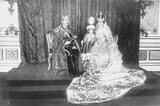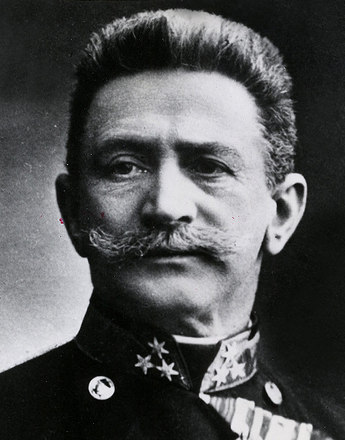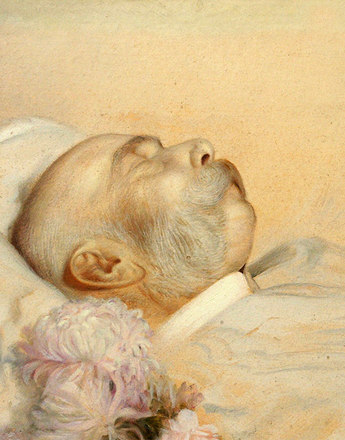-

Emperor Karl, Empress Zita and Archduke Otto at the funeral of Franz Joseph I on 30 November 1916, photo
Copyright: ÖNB Bildarchiv
Partner: Austrian National Library -

Emperor Karl, Empress Zita and Archduke Otto in the Hungarian coronation robes, photograph, 1916
Copyright: ÖNB Bildarchiv
Partner: Austrian National Library -

Speech by the heir to the throne Archduke Karl for the benefit of the Imperial-Royal Austrian Military Widows and Orphans Fund, sound recording, 16 February 1916
Copyright: Österreichische Mediathek
Partner: Österreichische Mediathek
After two years of war Austria-Hungary was economically and militarily entirely worn out. On 21 November 1916 a further blow came with the death of Emperor Franz Joseph, who had been an important linchpin for the unity of the decrepit Dual Monarchy.
This was the situation in which Emperor Karl took over the reins of power in November 1916. Karl was not only inexperienced, having hitherto only been involved on the political periphery, but also had no political backing of his own. For this reason he was dependent on the support of the principal political figures from the circle around the assassinated Archduke Franz Ferdinand, who had built up a team of political advisors as a kind of shadow government opposed to the old guard around Franz Joseph. The fact that Karl had recourse to this team was an ominous signal, as the circle around the former heir to the throne stood for an authoritarian course in Austrian politics.
This orientation was exemplified in Karl’s dismissal of Minister-President Ernest von Koerber, who had only been appointed by the ailing Franz Joseph at the end of October 1916. The reasons for the dismissal were differences of opinion and Koerber’s personal antipathy towards Karl. The main point of contention was that Koerber was urgently pleading for adherence to constitutional guidelines and a return to the constitutional state. This course was rejected by Karl, who wished to demonstrate a strong hand and carry out certain fundamental changes, which he could do more easily with the Reichsrat suspended. In Koerber’s place Karl appointed a member of the Austro-Bohemian high aristocracy, Count Heinrich Clam-Martinic, who had belonged to Franz Ferdinand’s inner circle and thus stood for markedly authoritarian policies.
In Hungary Karl decided for continuity and confirmed Count István Tisza in his office as Hungarian Minister-President. Although Tisza was a guarantor of stability in the kingdom of Hungary, Karl’s decision also ensured the continuation of the policy of Magyarization that had been pursued for so long at the cost of the country’s other nationalities.
Tisza took advantage of Karl’s inexperience by persuading him to lose no time in having himself crowned King of Hungary, using the argument that a coronation had great symbolic value and would strengthen the dynastic ideal. In fact, however, it led to a reduction in Karl’s political freedom of movement, as the coronation involved an oath to preserve the existing constitution and thus led to a corroboration of the status quo. Tisza also offered to extend the Compromise (on which the Dual Monarchy was based) for a further twenty years, which was an offer Karl could hardly refuse, as he was dependent on Hungarian support in order to consolidate his own position. By accepting, however, Karl committed a grave political error in that he forfeited the opportunity to begin his reign with far-reaching changes.
The hastily mounted coronation on 30 December 1916 was an archaic and absurd display of pomp and circumstance in which outdated rituals were made all the more ridiculous by the war being waged in the background.
Karl also appointed a new Foreign Minister in the person of Count Ottokar Czernin von Chudenitz, a Bohemian aristocrat who like Clam-Martinic had belonged to Franz Ferdinand’s circle of advisors.
There were also changes in the army leadership, with Archduke Friedrich being removed from his position as commander-in-chief; in addition, he was compensated for his dismissal by being awarded a number of honorary titles and the Maria Theresa Order, which in view of the way the war was going was widely seen as a scandal. On 2 December 1916 Karl took over the supreme command himself and with it direct responsibility for the conduct of the war. In order to show that a new wind was blowing he insisted that in January 1917 the army headquarters should be moved from Teschen (Austrian Silesia) to Baden near Vienna, so that it would be in his immediate vicinity.
Another figure on Karl’s list of undesirables was the Chief of General Staff, Franz Conrad von Hötzendorf. After the tension between the two had led to a showdown, their public opposition culminated in Conrad’s removal from office on 1 March 1917.
Translation: Peter John Nicholson
Bihl, Wolfdieter: Der Erste Weltkrieg 1914–1918. Chronik – Daten – Fakten, Wien/Köln/Weimar 2010
Gottsmann, Andreas (Hrsg.): Karl I. (IV.), der Erste Weltkrieg und das Ende der Donaumonarchie, Wien 2007
Hamann, Brigitte: Der Erste Weltkrieg. Wahrheit und Lüge in Bildern und Texten, 2. Aufl., München 2009
Hanisch, Ernst: Der lange Schatten des Staates. Österreichische Gesellschaftsgeschichte im 20. Jahrhundert [Österreichische Geschichte 1890–1990, hrsg. von Herwig Wolfram], Wien 2005
Hirschfeld, Gerhard/Krumeich, Gerd/Renz, Irina (Hrsg.): Enzyklopädie Erster Weltkrieg. Aktualisierte und erweiterte Studienausgabe, Paderborn/Wien [u.a.] 2009
Leidinger, Hannes/Moritz, Verena/Schippler, Bernd: Schwarzbuch der Habsburger. Die unrühmliche Geschichte eines Herrscherhauses (2. Auflage, ungekürzte Taschenbuchausgabe), Innsbruck [u.a.] 2010
Leidinger Hannes/Moritz, Verena: Der Erste Weltkrieg, Wien [u.a.] 2011
Rauchensteiner, Manfried: Der Erste Weltkrieg und das Ende der Habsburgermonarchie 1914–1918, Wien u. a. 2013
-
Chapters
- The enthusiasm for the war
- ‘Brothers in arms’: Austria-Hungary and Germany as partners and allies
- Front lines – The course of the war 1914–16
- Italy enters the war
- The impact of the war on civilian society
- The accession of Emperor Karl
- The Sixtus Letters – Karl’s quest for a way out
- Karl’s bid for freedom
- The Russian Revolution and its consequences
- 1917 – The turning point






